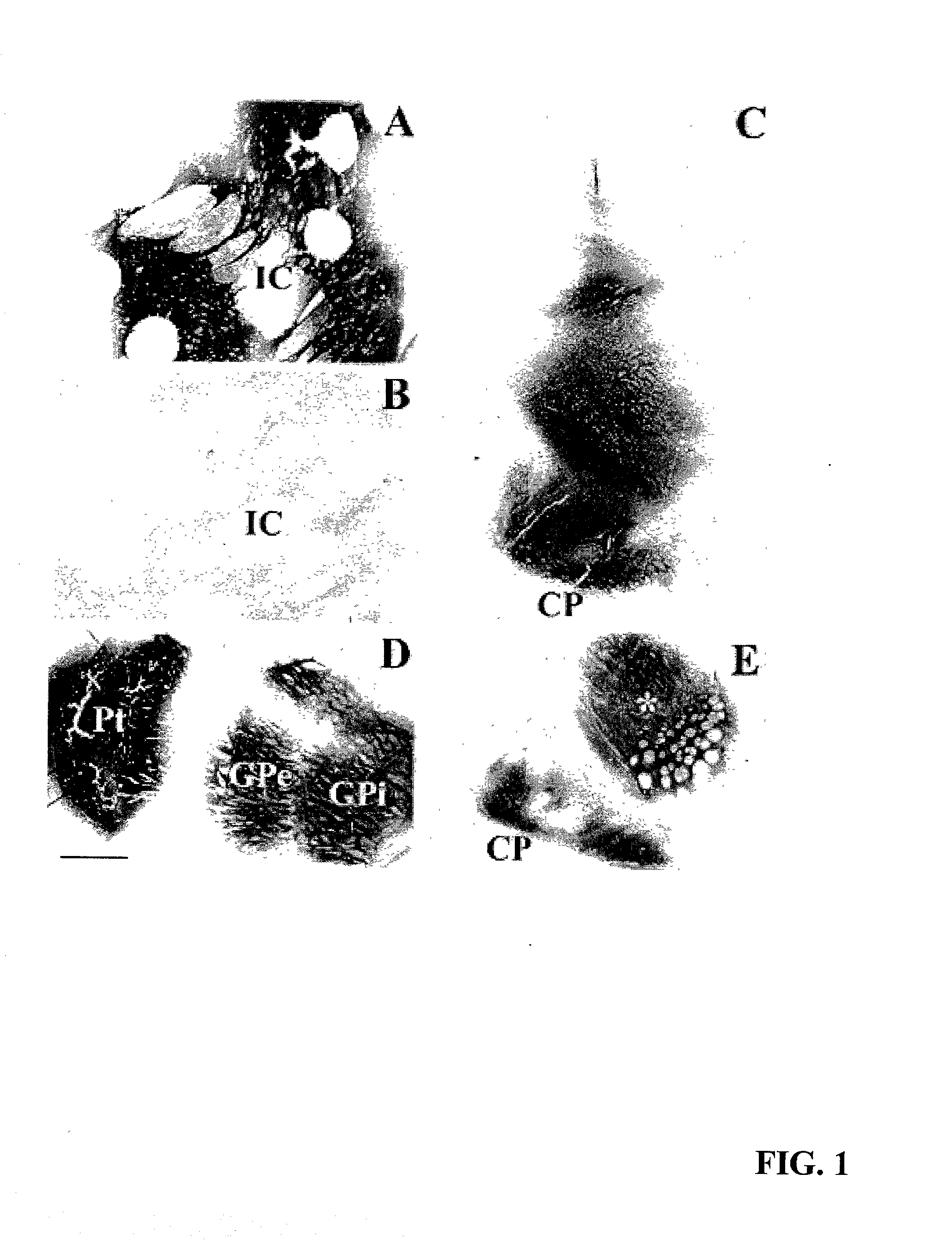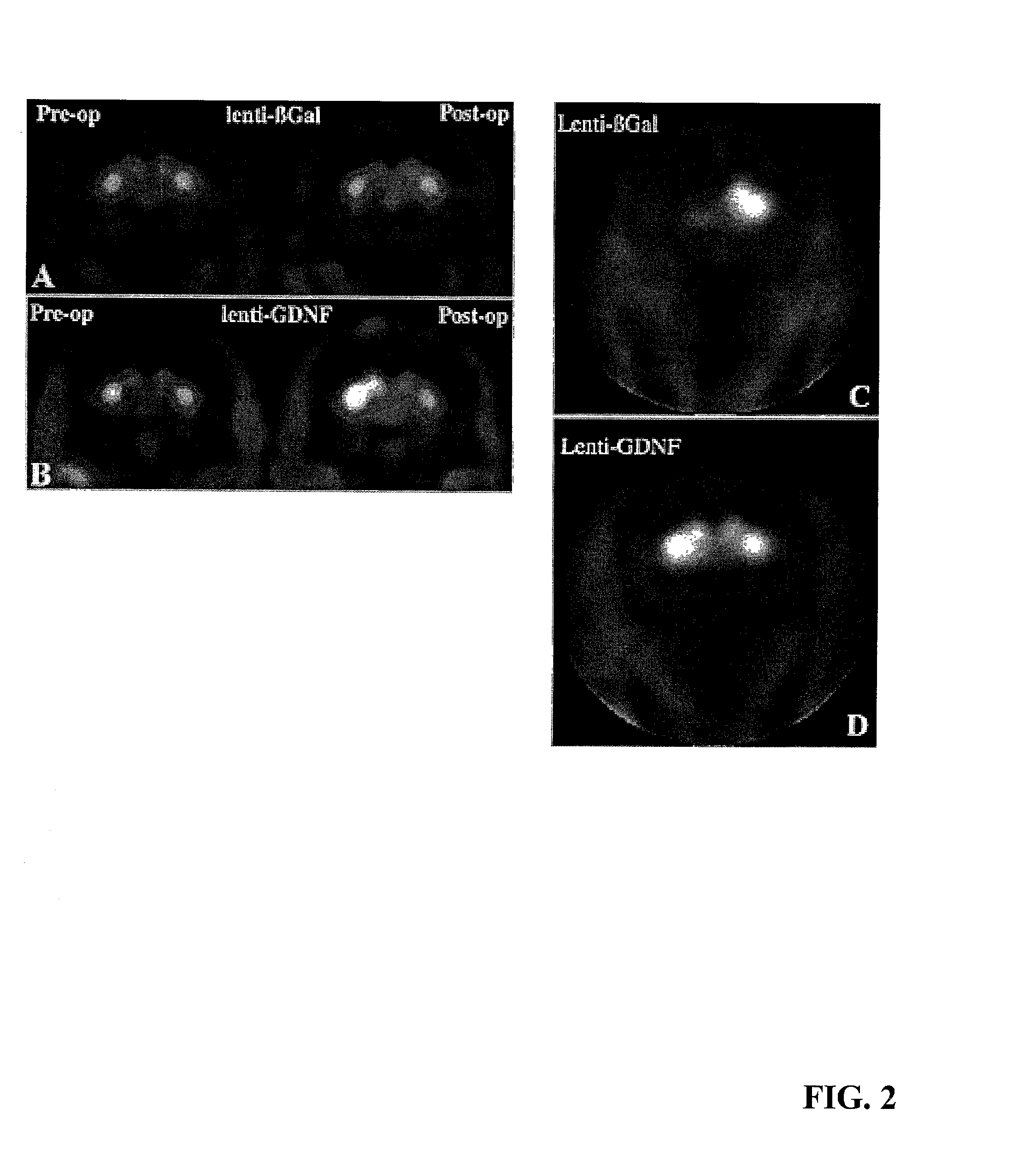Methods for therapy of neurodegenerative disease of the brain
- Summary
- Abstract
- Description
- Claims
- Application Information
AI Technical Summary
Benefits of technology
Problems solved by technology
Method used
Image
Examples
example ii
Transgene Expression and Anterograde Transport of GDNF Expression Product Within the Aged Primate Brain
[0061] Non-lesioned aged monkeys that model PD like neurodegeneration (17) display a slow progressive loss of dopamine within the striatum and tyrosine hydroxylase (TH) within the substantia nigra without frank cellular degeneration. Eight aged (approximately 25 years old) female rhesus monkeys received injections of lentiviral vectors encoding galactosidase (lenti-Gal; n=4) or GDNF (lenti-GDNF; n=4) targeted for the striatum and substantia nigra and were killed 3 months later.
[0062] Under MRI guidance, each monkey received six stereotaxic injections of lenti-Gal or lenti-GDNF bilaterally into the caudate nucleus, putamen, and substantia nigra. Injections were made into the head of the caudate nucleus (10 .mu.l), body of the caudate nucleus (5 .mu.l), anterior putamen (10 .mu.l), commissural putamen (10 .mu.l), postcommissural putamen (5 .mu.l), and substantia nigra (5 .mu.l). Inje...
example iii
DOPA Uptake Following GDNF Treatment in Aged Animals
[0067] Aged monkeys underwent fluorodopa (FD) positron emission tomography (PET) before surgery and again just before being killed. Before treatment, all monkeys displayed symmetrical FD uptake in the caudate and putamen bilaterally (ratio: 1.02.+-.0.02) (FIGS. 2A and 2B, left). Similarly, there was symmetrical (4% difference) FD uptake in all lenti-Gal-treated monkeys after lentivirus injections (FIG. 2A, right).
[0068] In contrast, FD uptake was significantly asymmetrical (27%) in lenti-GDNF-treated monkeys with greater uptake on the side of the GDNF expression (P<0.007; FIG. 2B, right). With respect to absolute values, lenti-Gal animals displayed a trend toward reduced FD uptake after treatment relative to baseline levels (P=0.06). Qualitatively, three of four lenti-GDNF-treated monkeys displayed clear increases in FD uptake on the treated side.
[0069] Within the striatum, lentiviral delivery of GDNF increased a number of markers ...
example iv
Neuron Generation in Aged Animals
[0071] Lentiviral delivery of GDNF to aged monkeys resulted in an increase in the number of TH-immunoreactive neurons within the substantia nigra (FIG. 3, C and D). Regardless of the extent of GDNF immunoreactivity within the midbrain, the organization of TH-immunoreactive neurons was similar in all animals, and these neurons were not observed in ectopic locations within this locus.
[0072] Stereological counts revealed an 85% increase in the number of TH-immunoreactive nigral neurons on the side receiving lentivirally delivered GDNF (FIG. 4A) relative to lenti-Gal-treated animals. On the side (left) that did not display GDNF immunoreactivity, lenti-GDNF-treated animals contained 76,929.+-.4918 TH-immunoreactive neurons. This is similar to what was seen in lenti-Gal-infused animals (68,543.+-.5519). Whereas lenti-Gal-infused monkeys contained 63,738.+-.6094 TH-immunoreactive nigral neurons in the right side, lenti-GDNF-treated monkeys contained 118,170...
PUM
| Property | Measurement | Unit |
|---|---|---|
| Length | aaaaa | aaaaa |
| Time | aaaaa | aaaaa |
| Concentration | aaaaa | aaaaa |
Abstract
Description
Claims
Application Information
 Login to View More
Login to View More - R&D
- Intellectual Property
- Life Sciences
- Materials
- Tech Scout
- Unparalleled Data Quality
- Higher Quality Content
- 60% Fewer Hallucinations
Browse by: Latest US Patents, China's latest patents, Technical Efficacy Thesaurus, Application Domain, Technology Topic, Popular Technical Reports.
© 2025 PatSnap. All rights reserved.Legal|Privacy policy|Modern Slavery Act Transparency Statement|Sitemap|About US| Contact US: help@patsnap.com



